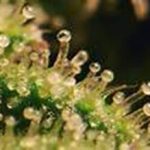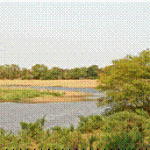TREE LIFE
October 2013
MASHONALAND CALENDAR
Sunday, October 20th: Raintree
This will be our second visit to Raintree, by the Umwinsi River. We first went there in July 2010 and saw a number of interesting species along the river. Please bring a chair, water, a hat and a packed lunch. We will meet at the usual time of 9:30 am.
Saturday, October 26th: 10 Cockington Road, Mandara
Our 4th Saturday walk will be a visit to the garden of Peter Munday and Desna Campbell in Mandara. Amongst the interesting species we will see is a specimen of the Fern-leaf, Filicium decipiens, a rather rare species from the lower altitude parts of the Eastern Districts. We will meet at 2:30 pm.
TREE OF THE MONTH
Faidherbia albida
Family: – Fabaceae – Mimosoideae
The Fabaceae, being so numerous, have been subdivided into three sub-families: Mimosoideae, Papilionoideae and Caesalpinoideae; Faidherbia albida is in the Mimosoideae.
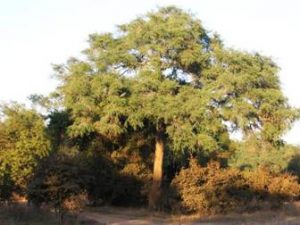
Faidherbia albida
One characteristic that all Fabaceae share is formation of symbiotic associations with one of the Rhizobia bacteria. This includes all our Brachystegia, Acacia (now Vachelia or Senegalia), Erythrina, Pterocarpus, Philenoptera, Albizia and more have a symbiotic relationship with Rhizobia. So have common legume crops and forage: peas, beans, clover, etc.
Soil is far from being an inert material, a kilo of soil contains some 2 trillion bacteria, 400 million fungi, 50 million algae, 30 million protozoa, nematodes, other worms and insects. In this article we will concentrate on the role of bacteria.
Atmospheric nitrogen molecules cannot be used directly by plants, but the Rhizobium produces an enzyme, nitrogenase, that can reduce atmospheric nitrogen into ammonium usable by plants. Rhizobia are unique in that they are the only nitrogen-fixing bacteria living in a symbiotic relationship with legumes.
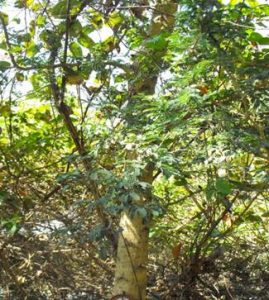
Mature F. albida trees on the flood plain at Mana Pools are one of the major sources of food for animals and birds
The “infection” process: The symbiotic relationship implies a signal exchange between both partners that leads to mutual recognition and development of symbiotic structures. Rhizobia live in the soil where they are able to sense flavonoids secreted by the roots of their host legume plant. Flavonoids trigger the secretion of nodulation factors which in turn are recognised by the host plant and lead to root hair deformation and several other cellular responses. The best-known infection mechanism is called intracellular infection; in this case the rhizobia enter through a deformed root hair, forming an intracellular tube called the infection thread.
The infection triggers cell division in the cortex of the root where a new organ, the nodule, appears as a result. Infection threads grow to the nodule, infect its central tissue and release the rhizobia in these cells which fix nitrogen from the atmosphere, using the enzyme nitrogenase. In return, the plants supplies the bacteria with carbohydrates, proteins and sufficient oxygen so as not to interfere with the fixation process. The legume–rhizobium symbiosis is a classic example of mutualism – rhizobia supply ammonia or amino acids to the plant and in return receive organic acids as a carbon and energy source.
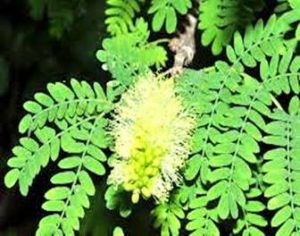
Faidherbia albida flowers and leaves
Faidherbia albida favours low altitudes and particularly along river courses and flood plains or wherever the water table is high. In Zimbabwe it is mostly seen in the Zambezi and Limpopo valleys. It is a fast growing tree, up to 1 m per year. Old specimens can grow to 30 metres height; planted specimens tend to be smaller at around 15 metres.
The leaves are bipinnate with 3 to 10 pairs of pinnae and 6 to 23 leaflets pairs per pinnae. The inflorescence is a long spike of yellow-white flowers, it grows from the axils of the young growths from May to July, after the leaves.
The fruit is twisted, reddish brown to bright orange. It is indehiscent, thick, broad and fleshy; it falls from the tree from August to November, providing good forage for many species, both wild and domestic. The mature F. albida trees on the flood plain at Mana Pools are one of the major sources of food for animals and birds in the dry winter period.
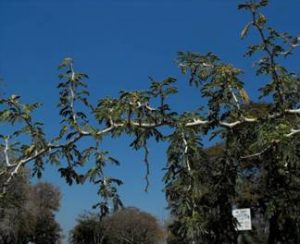
branches tend to grow in a zigzag pattern
The thorns, around 2 cm long, are white, paired at the node, stout and strong but never swollen. The branches tend to grow in a zigzag pattern, changing direction at every node. In young trees they are whitish but in older trees they become grey. A mature tree can reach a bole diameter of 1½ metres but in practice it ranges from 70 to 100 cm.
An interesting character of Faidherbia is that it loses its leaves before the wet season. The fallen leaves provide an excellent green manure rich in nitrogen to the soil around. In countries to the North of us, Faidherbia albida is used extensively and successfully in agro-forestry, even in drought stricken areas. The general belief that the tree requires a wet and hot environment is contradicted by some authors who maintain that it can sustain a fair amount of drought and frost. Interestingly Acacia xanthophloea, the Fever tree, is another tree that does not (in Zimbabwe) grow in the wild outside the flood plains of the Limpopo and at altitude above 500 metres. It nevertheless seems to thrive in many gardens around Harare.
Faid herbia albida bark and roots are used to treat skin infections, respiratory infections and digestive disorders as well as malaria and other fevers, while the bark is used to clean teeth. An extract has been used to treat eye and ocular infections in animals. The wood is light and easily attacked by borer. In the past it was used to make dug-out canoes. Its main use for humans now is limited to agro-forestry.
Sources: Wikipedia; Le Houérou Faidherbia albida www.fao.org; Moore et al 1996. Botany Vol 2. McGraw Hill, New York.; Plantz Africa www.plantzafrica.com.
– JP Felu
TREE SOCIETY VISIT TO MALILANGWE CONSERVATION TRUST, CHIREDZI 29th August – 2nd September
Day One- 29th August Hippo Camp and surrounds
When the Tree Society committee, prompted by John Meikle, were discussing an outing to the Lowveld at the end of winter, we had several options to explore, one of which was the Malilangwe Conservation Trust in Chiredzi. I had visited Malilangwe as part of a research team a couple of times in the distant past and was keen to return. Then a chance meeting with Torrah Ballance up at the Chimanimani Hut at Easter, who gave me the CEO’s contact details, sealed our choice.
Malilangwe has an outreach programme which allows groups like the Tree Society, as well as schools, to visit the extensive property which is about 10 km outside Chiredzi on the Chisumbanje road. Visitors to the Chipinda Pools camp in Gonorezhou have to drive through Malilangwe to get to the Parks’ entrance. We were lucky enough to be given permission to stay at one of the staff camps by the Trust’s CEO, Mark Saunders.
The organisation of our visit was hugely facilitated by Karl van Laeren, who is a vet on the horse programme at Malilangwe and who knows both the staff and the area well. A big thank you to Karl for all his help.
The well organised camp where we were to stay, Hippo sometimes called Safari Camp, is in a delightful spot on the edge of a tributary of the Chiredzi River. There are two ways to get to the camp, one through the main gate and across the Chiredzi River, where a 4×4 makes crossing less worrisome, and one with a guide through the neighbouring banana groves. The camp comprises a large dining area with a sitting room that looks out over the water, surrounded by four rondavels that can house eight people. The site is kept neat and tidy by two very efficient and helpful staff, who made our stay even more enjoyable. The green lawn would be attractive to the local game except for an electric fence that keeps visitors safe when walking from their rooms to the dining area. The lawn also provided a comfortable place for Karl and Annelie to camp, because we had originally been told the camp housed 10.
Bilal, Richard Hartnack and I went down a day early, on Wednesday 28th August, so I could have discussions with Malilangwe’s ecologist Dr Bruce Clegg, and we met Karl and Annelie there. It was an easy 6-hour drive down and I was glad to spend a few quiet hours in the bush before the activity started in earnest. The large Cordylas in full flower across the river were hives of bird life and we were lucky to see some game coming down to drink – bushbuck, kudu, elephants and hippo, as well as the resident crocs. Karl had told us that we might be able to see two of the trees in Lyn Mullin’s book ‘Historic Trees of Zimbabwe’, so I had brought my copy to read. The pool below the camp attracted large numbers of fireflies as the dusk developed, which were magical to watch as Bilal braaied his delicious chicken for our dinner.
The other members of the group – Meg Coates-Palgrave, Mary Lovemore, Vernon and Marylin Dickinson and Carolyn Dennison – arrived the next day and once the heat had diminished we all piled into Karl’s Landcruiser which had a seat on the back for game and tree viewing. It was much more congenial to be together in one vehicle, so we didn’t mind the squeeze.
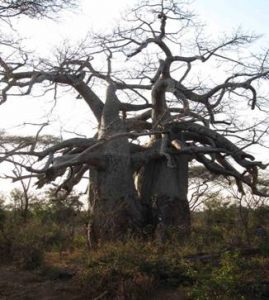
‘The Lovers’, two closely clasped baobabs which were the first of Lyn Mullin’s Historic Trees
We drove back towards the banana groves through clumps of Salvadora persica, the Toothbrush or Mustard tree, and Thilacium africanum, the Cucumber bush, Maerua parvifolia, Capparis sepiaria and twining Cissus rotundifolia; past majestic Xanthocercis zambesiaca, the Nyala tree, and Dalbergia melanoxylon, Ebony Dalbergia, as well as numerous baobabs and the scented flowering Albizia anthelmintica interspersed with Ziziphus mucronata, Grewia bicolor and G. flavescens, as well as Gardenia volkensii, We stopped to identify them all along the way and the vehicle gave us the lift we needed to reach higher branches. Our aim was to see ‘The Lovers’, two closely clasped baobabs near the edge of the property, which were the first of Lyn Mullin’s Historic Trees. The weather was balmy so we ended with sundowners as the sun dropped behind an Acacia tortilis grove and then returned to the camp for the first of our delicious shared meals.
– Isla Grundy
Day Two – 30th August The Stables Area
Friday was a beautiful day at Malilangwe’s secluded Hippo Camp, a place so secret it is not even on the map. The Tree Society was packed early into Karl van Laeren’s Landcruiser and covered about two yards in reverse before the power steering unit burst open, spilling crimson fluid onto the ground. Nothing deterred, Meg disembarked and assembled a group of enthusiasts to look at some of the trees around the campsite parking area. Near the vehicle stood four plants: Gymnosporia putterlickioides, Salvadora persica, Acacia ataxacantha and Capparis sepiaria. Later, at the Malilangwe stables, we would see another G. putterlickioides looking much more characteristically spiny. The Capparis would soon reveal itself as the dominant roadside plant in the roads we drove along through the property. Called the Hedge caper-bush, it has short but sharp downward-pointing spines closely flanking each leaf, and distinctive green bark. In appearance it is a brambly plant. S. persica, the Mustard tree, is also a trailing, scrambling shrub associated with lowveld riverine vegetation.
Meanwhile Karl and Annelie had succeeded in communicating with mechanics about the Landcruiser, so we got into other vehicles and set out for the Malilangwe stables. These are pristine and very impressive. We were met by professional guide Ant Kaschula, who turned out to be very knowledgeable indeed, and he, Karl and Meg led our walk together after tea. This walk led us along the road beside the paddock and ended in the wooded shade of some overhanging sandstone cliffs. Along the way, 27 plant species were noted, with 21 positively identified and a few question marks over the rest. It was now 11.30am, and the lowveld temperature felt slightly on the upper side of 30 degrees, so hats and shades were welcome. A tree associated with the lowveld is Xanthocercis zambesiaca, the Tamboti, which has spiny branchlets and small scalloped leaves which turn brilliant shades of red and yellow before falling. One grows opposite the main entrance to the stables and nearby is a thicket made up of Phyllanthus reticulatus, or the Potato bush. According to Coates Palgrave “The flowers of this plant are responsible for the strange smell of potatoes which is so often encountered along river banks in the lowveld, particularly on spring and summer evenings. This is one of the most characteristic smells of Africa.”
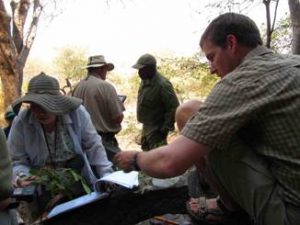
Identifying specimens in a shady spot
Ant and Meg noticed a lot of interesting plants: Combretum apiculatum, the Glossy Combretum, whose glossy leaves often turn over at the tips, and one of which Meg wasn’t sure, possibly Boscia foetida, the Bushveld shepherd’s tree. Ant then pointed out a couple of small non-woody plants which might have been missed: Waltheria indica and Sida cordifolia, the latter a considerable weed, with uncertainty over whether it is native to Zimbabwe or introduced. Another small shrub, common in Mopane veld, is the strong-smelling Maerua decumbens. The woodland at this site includes Albizia petersiana, or Many-stemmed false thorn, which is extensively browsed by elephants. Proceeding past a specimen of Combretum microphyllum and sampling some very tasty Hyphaene petersiana (Ilala palm) fruit, we went on to view specimens of Piliostigma thonningii, Monkey bread, Dalbergiella nyasae, Mane-pod, and Diospyros mespiliformis, or Jackal-berry. Another species of Diospyros was also spotted, D. loureiriana, the Dye star-apple. The latter provides deep shade and the mane-pod has very distinctive velvety pods fringed all the way round with dense dark hairs. There was the unusual Tarenna zygoon, also known as Coptosperma, and also a specimen of Senna singueana, the Winter Senna, with its striking flowers and conspicuous glands between the pairs of leaflets.
Proceeding past a beautiful Brachystegia glaucescens we next came to a specimen of Ochna barbosae and one of the Lowveld Bead-string, Alchornea laxiflora. This diverse woodland also contained the Purple hook-berry Artobotrys brachypetalus, with its interesting shepherd’s crook peduncles on which the flowers are borne and Androstachys johnsonii, the Lebombo ironwood, a tree whose furry leaves were responsible for causing bulldozers to overheat during tsetse control operations in the 1960s. The Tabernaemontana elegans, the Toad tree, is in evidence in this woodland as well – there are several specimens in the vicinity of the stables. Finally beneath the shady sandstone cliffs we were able to rest and amuse ourselves with the intriguing winged seeds of the Propeller tree, Gyrocarpus americanus. These seeds, when thrown in the air, fly off in a very satisfactory way like miniature helicopters.
After returning to the stables for an enjoyable lunch and some rest, in the later afternoon we were invited on another botanising walk, this time in another direction. On this walk we were able to learn the difference between the “true” and “false” Tamboti trees. The former, Spirostachys africana, has a serrated leaf and milky sap but Cleistanthus schlecteri, which is sometimes mistaken for the Tamboti, is a very different tree with an entire margined leaf and no latex. The misidentification occurs because of the colour of the Cleistanthus leaves which also turn red-brown before falling. We saw an impressive specimen of Ficus abutilifolia, the Finger leaf, as well as Vitex mombassae and Holarrhena pubescens, the latter’s seeds equipped with dense tufts of silky hairs which enable them to float away in the wind. The Sabi Star, Adenium multiflorum, with its beautiful red and white flowers which are such a flag post of this area, was also visible in the woodland and a real treat was to find a naturally bonsai-ed Baobab, growing in a crevice in a rock.
Just before returning to the stables, a quick turn by the Malilangwe office block revealed a few extra trees of interest: Grewia salcata with 4-berry clusters, Rauvolfia caffra, the Quinine tree, a planted specimen of Millettia stuhlmannii, Panga Panga, which produces fine timber, and a thorny-barked Erythrina livingstoniana, which is always unmistakeable.
After two days in Malilangwe we had a very thorough sense of the kinds of flora to be found in the Lowveld. A recurring comment, though, throughout this and other days was from Meg who warned against “remote sensing” and emphasised the need to examine any plant however small and insignificant with a lens.
– Richard Hartnack
– TO BE CONTINUED –
Tree Society outing to Thetford September 15, 2013
A day with a difference is the best way to describe our visit to Thetford. And a big thank you to Mark Brightman for inviting and hosting us.
Mark provided two safari style landrovers and most of us were able to haul ourselves up onto the seats one way or another and off we set. Our first sighting was a fish eagle perched on a leafless tree. Thetford is a game park and the area had been burnt recently as a tick control measure. We hadn’t gone very far before we stopped and had to haul ourselves off again to have a look at the trees along a little tributary of the Mapfeni River.
The first tree we looked at was a much browsed Sweet thorn, Acacia karroo. Yes I know I should, strictly speaking, not have called it that. The name Acacia has been hijacked by the Australians and a formal name change for the Acacias has now been published. So my only excuse is that I haven’t got around to making all the changes in my system yet. I always seem to have something else with a higher priority to do. There is no doubt that the Acacias ‘sensu lata’ or ‘as we have known them up to now’ should be put in different genera. Those with straight spines and flowers in little balls should have remained Acacia, but have now become Vachellia. They are different from the Acacias, ‘sensu lata’ with hooked prickles in pairs and flowers in spikes, now Senegalia and probably should been changed to that years ago. I don’t have a problem with that change. It is quite logical. However there are also Acacias with scattered prickles, some of which have flowers in little balls and some of them have flowers in spikes, so are also obviously different but they all have just been dumped in Senegalia.
Although not running, the water in the stream obviously wasn’t far below the surface because there were lots of trees usually considered to be strictly riverine. Wild Olive, Olea africana, dark green, with stiff, opposite leaves tapering to a point at the apex and almost bent back at the tip, in contrast to the River Bushwillow, Combretum erythrophyllum, standing tall with its pale greyish brown to yellowish bark. Rhamnus prinoides, Shiny-leaf, is another species seldom found away from water. Later we saw Salix mucronata, Wild Willow, standing in the river actually in the water. It is a rheophyte, something that has it’s trunk washed by water at least some of the year. I have seen the Wild Willow in a dry river bed but obviously the water wasn’t far below and the river flowed during the rainy season.
We looked at the leaves of Pterolobium stellatum, Red-wing. These had a distinct pair of prickles on the undersurface of the rachis at the base of each pair of pinnae but we couldn’t find the single straight one between the pairs of pinnae, on the top. Someone did eventually find an example of leaves with the straight spines on top and later we even saw one with red pods in the distance.
A bit further on was a very tall Celtis africana, White stinkwood, in pale green new leaf and just coming into flower, next a little group of Searsia lancea, Willow crowberry, which have very flexible branches and are popular for making bows. Nearby was Vangueria randii, Antheap wild-medlar. On the way back to the vehicle walking over an area that had been burnt was the Dwarf red Combretum, Combretum platypetalum, so typical of burnt areas, just peeping through.
From then on it was treeing from the comfort of the landrover which also meant we were able to cover quite a lot of ground and record about 65 trees, including some which I definitely consider honorary trees such as Rhoicissus tridentata, Bitter Grape, which is much more a climber than a tree, but it has been included on the South African tree list so it must be a tree, at least somewhere. I admit I have once seen it with a trunk more than 5 cm in diameter.
Thetford had been a tobacco farm until 1999. Originally the woodland had been cut down to grow and then to cure tobacco. So there was a mixture of old lands now grassland and regenerating miombo woodland. Most of the trees were quite slender as one would expect from about 14 years of regrowth. I thought it was very exciting to see how well the woodland was coming back naturally. During the drive we saw lots of game, including sable, tsessebe,, waterbuck, kudu, impala, giraffe, eland. Unfortunately the last two mentioned are quite destructive browsers with little respect for trees other than as food to be ripped off.
Cassia abbreviata, Sjambok pod, with yellow flowers, Dombeya rotundifolia, Wild-pear in white flower and Erythrina abyssinica, Red-hot-poker Coral-tree, with red flowers standing upright, all added to the colour and pleasure of the trip. A surprise in a woodland, although in quite a rocky area was a small Diospyros natalensis subsp. nummularia, Granite Jackal-berry or Tickey-tree for those who remember the days of tickeys, because of it’s small round leaves.
And the mystery tree? I had another look at the leaves and took it to the herbarium. It must be Garcinia huillensis, Granite Mangosteen. It can’t be anything else: opposite leaves, no interpetiolar ridge, many fine lateral veins at quite a narrow angle to the midrib, which run almost all the way to the margin but not forming a sub-marginal vein as they do in the leaves of the Waterberries, Syzygium. We did see both Syzygium cordatum, Waterberry, with no petiole, right next to the water and Syzygium guineense subsp. guineense, Woodland waterberry.
A most enjoyable day. Very many thanks to Mark Brightman for making it so.
– Meg Coates Palgrave


